电子垃圾论文
如何处理电子垃圾作文
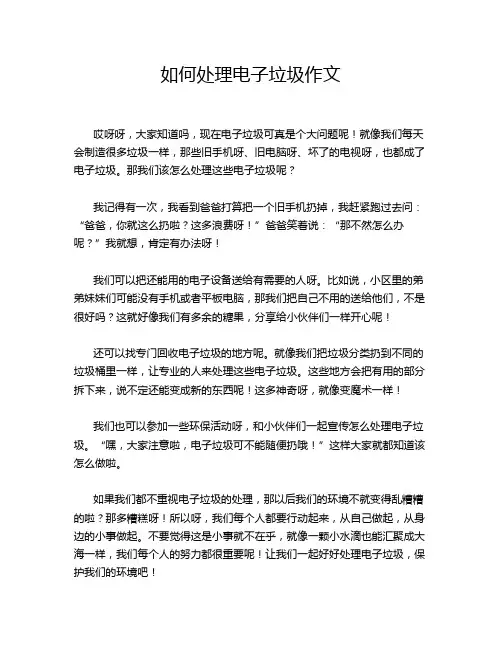
如何处理电子垃圾作文
哎呀呀,大家知道吗,现在电子垃圾可真是个大问题呢!就像我们每天会制造很多垃圾一样,那些旧手机呀、旧电脑呀、坏了的电视呀,也都成了电子垃圾。
那我们该怎么处理这些电子垃圾呢?
我记得有一次,我看到爸爸打算把一个旧手机扔掉,我赶紧跑过去问:“爸爸,你就这么扔啦?这多浪费呀!”爸爸笑着说:“那不然怎么办呢?”我就想,肯定有办法呀!
我们可以把还能用的电子设备送给有需要的人呀。
比如说,小区里的弟弟妹妹们可能没有手机或者平板电脑,那我们把自己不用的送给他们,不是很好吗?这就好像我们有多余的糖果,分享给小伙伴们一样开心呢!
还可以找专门回收电子垃圾的地方呢。
就像我们把垃圾分类扔到不同的垃圾桶里一样,让专业的人来处理这些电子垃圾。
这些地方会把有用的部分拆下来,说不定还能变成新的东西呢!这多神奇呀,就像变魔术一样!
我们也可以参加一些环保活动呀,和小伙伴们一起宣传怎么处理电子垃圾。
“嘿,大家注意啦,电子垃圾可不能随便扔哦!”这样大家就都知道该怎么做啦。
如果我们都不重视电子垃圾的处理,那以后我们的环境不就变得乱糟糟的啦?那多糟糕呀!所以呀,我们每个人都要行动起来,从自己做起,从身边的小事做起。
不要觉得这是小事就不在乎,就像一颗小水滴也能汇聚成大海一样,我们每个人的努力都很重要呢!让我们一起好好处理电子垃圾,保护我们的环境吧!。
英语作文电子垃圾的危害
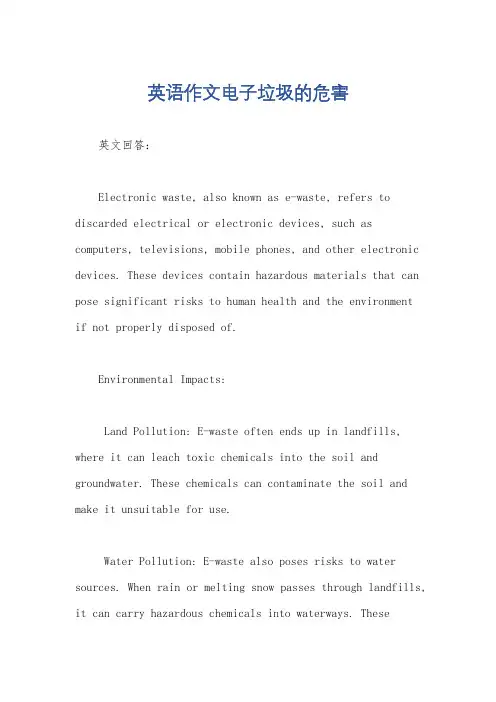
英语作文电子垃圾的危害英文回答:Electronic waste, also known as e-waste, refers to discarded electrical or electronic devices, such as computers, televisions, mobile phones, and other electronic devices. These devices contain hazardous materials that can pose significant risks to human health and the environmentif not properly disposed of.Environmental Impacts:Land Pollution: E-waste often ends up in landfills, where it can leach toxic chemicals into the soil and groundwater. These chemicals can contaminate the soil and make it unsuitable for use.Water Pollution: E-waste also poses risks to water sources. When rain or melting snow passes through landfills, it can carry hazardous chemicals into waterways. Thesechemicals can harm aquatic life and make the water unsafe for drinking.Air Pollution: E-waste can release toxic fumes when it is incinerated. These fumes can contribute to air pollution and cause respiratory problems in humans.Human Health Impacts:Exposure to Toxic Chemicals: E-waste contains avariety of toxic chemicals, including heavy metals, such as lead and mercury, and brominated flame retardants. These chemicals can cause neurological damage, developmental disorders, and cancer.E-waste Fires: E-waste fires can release harmful chemicals into the air, which can cause respiratory problems and other health issues.Occupational Health Hazards: People who work in the e-waste recycling industry are often exposed to toxic chemicals and hazardous conditions. These workers cansuffer from a range of health problems, includingrespiratory diseases, skin problems, and reproductivehealth issues.Social and Economic Impacts:Informal Recycling: E-waste is often recycled in informal settings, where workers lack proper safety equipment and environmental protections. These workers can be exposed to hazardous chemicals and may not receive fair compensation for their work.Loss of Resources: E-waste contains valuable materials, such as copper, gold, and silver. However, if thesematerials are not properly recycled, they can be lost tothe environment.Economic Costs: The improper disposal of e-waste can also lead to economic costs, such as the cost of cleaningup contaminated land and water, and the cost of treating health problems caused by exposure to toxic chemicals.Addressing the Problem:Addressing the problem of e-waste requires a comprehensive approach involving governments, businesses, and consumers. Some key steps include:Increased Recycling: Governments should implement policies that encourage the recycling of e-waste and makeit more accessible to consumers.Extended Producer Responsibility: Businesses should be held responsible for the end-of-life management of their products, including the recycling of e-waste.Public Education: Consumers need to be educated about the dangers of e-waste and the importance of proper disposal.International Cooperation: The problem of e-waste is a global one, and it requires international cooperation to develop and implement effective solutions.中文回答:电子垃圾的危害。
阐述电子垃圾的危害英语作文
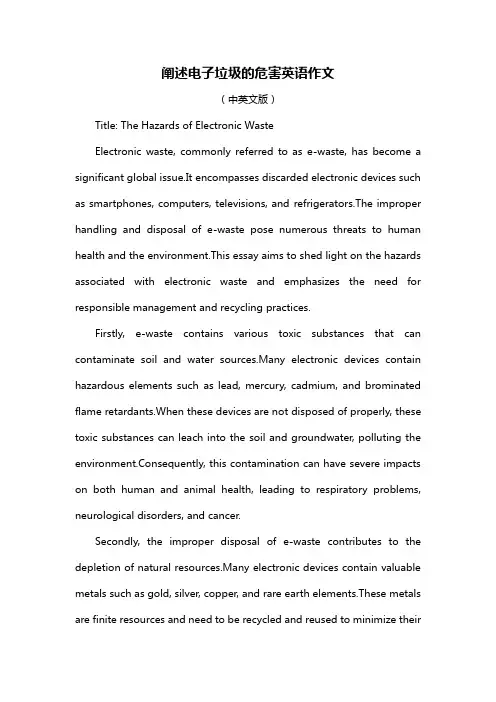
阐述电子垃圾的危害英语作文(中英文版)Title: The Hazards of Electronic WasteElectronic waste, commonly referred to as e-waste, has become a significant global issue.It encompasses discarded electronic devices such as smartphones, computers, televisions, and refrigerators.The improper handling and disposal of e-waste pose numerous threats to human health and the environment.This essay aims to shed light on the hazards associated with electronic waste and emphasizes the need for responsible management and recycling practices.Firstly, e-waste contains various toxic substances that can contaminate soil and water sources.Many electronic devices contain hazardous elements such as lead, mercury, cadmium, and brominated flame retardants.When these devices are not disposed of properly, these toxic substances can leach into the soil and groundwater, polluting the environment.Consequently, this contamination can have severe impacts on both human and animal health, leading to respiratory problems, neurological disorders, and cancer.Secondly, the improper disposal of e-waste contributes to the depletion of natural resources.Many electronic devices contain valuable metals such as gold, silver, copper, and rare earth elements.These metals are finite resources and need to be recycled and reused to minimize theirconsumption.However, when e-waste is dumped in landfills or undergoes informal recycling processes, these valuable resources are often lost, leading to increased extraction of raw materials from the environment.Furthermore, the informal recycling of e-waste can lead to occupational health hazards for the individuals involved in the recycling process.In many developing countries, e-waste is often dismantled manually, exposing workers to toxic substances without proper safety gear or protection.This results in health issues such as skin disorders, respiratory problems, and cardiovascular diseases.To mitigate the hazards of e-waste, it is crucial to adopt responsible e-waste management ernments, organizations, and individuals must work together to promote the proper recycling and disposal of electronic waste.This can be achieved through the establishment of e-waste recycling facilities, the implementation of strict regulations, and public awareness campaigns to educate individuals about the importance of recycling their electronic devices.In conclusion, the improper handling and disposal of e-waste pose significant hazards to human health and the environment.Toxic substances contained in e-waste can contaminate soil and water sources, leading to various health issues.Additionally, the improper disposal of e-waste contributes to the depletion of valuable resources and occupational health hazards for those involved in informal recyclingprocesses.It is essential for governments, organizations, and individuals to adopt responsible e-waste management practices to mitigate these hazards and protect both human health and the environment.。
电子垃圾处理循环经济论文
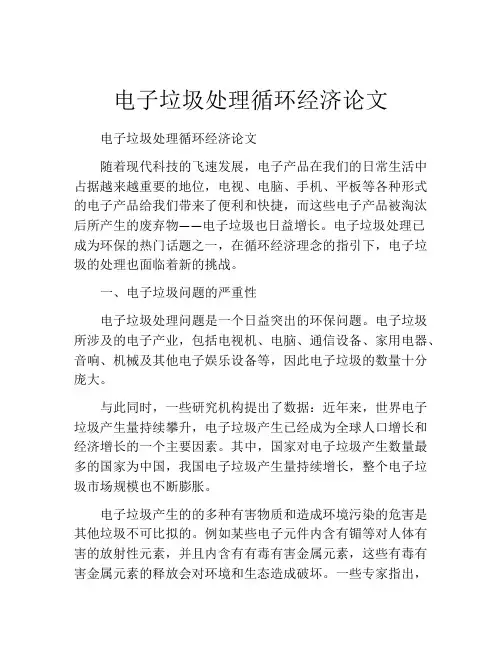
电子垃圾处理循环经济论文电子垃圾处理循环经济论文随着现代科技的飞速发展,电子产品在我们的日常生活中占据越来越重要的地位,电视、电脑、手机、平板等各种形式的电子产品给我们带来了便利和快捷,而这些电子产品被淘汰后所产生的废弃物——电子垃圾也日益增长。
电子垃圾处理已成为环保的热门话题之一,在循环经济理念的指引下,电子垃圾的处理也面临着新的挑战。
一、电子垃圾问题的严重性电子垃圾处理问题是一个日益突出的环保问题。
电子垃圾所涉及的电子产业,包括电视机、电脑、通信设备、家用电器、音响、机械及其他电子娱乐设备等,因此电子垃圾的数量十分庞大。
与此同时,一些研究机构提出了数据:近年来,世界电子垃圾产生量持续攀升,电子垃圾产生已经成为全球人口增长和经济增长的一个主要因素。
其中,国家对电子垃圾产生数量最多的国家为中国,我国电子垃圾产生量持续增长,整个电子垃圾市场规模也不断膨胀。
电子垃圾产生的的多种有害物质和造成环境污染的危害是其他垃圾不可比拟的。
例如某些电子元件内含有镅等对人体有害的放射性元素,并且内含有有毒有害金属元素,这些有毒有害金属元素的释放会对环境和生态造成破坏。
一些专家指出,电子垃圾里的有毒金属,如镉、铅、汞、铬等,如果被乱丢乱倒或不合规处理,则关系着不仅是环境和生态,同时也关系到人类的健康与生命。
而一些电子垃圾中的“废物宝石”也存在着短缺问题,若能回收再利用,这对于节约自然资源和保护生态环境都是非常重要的。
二、电子垃圾的处理方式目前,处理电子垃圾的方法主要是通过卫生管理部门委托专业机构单独或合作处理,其中包括回收再利用、危险废物处理、焚烧处理、灭菌消毒处理等多种处理方式。
(一)回收再利用前文提到的“废物宝石”,也就是电子垃圾中潜在的可回收资源,例如金、银等贵重金属及其它重有色金属、稀土金属、塑料、玻璃等,都可以重新利用。
我们可以通过回收再利用这些金属等资源,减少资源的开采量。
同时,减少资源的开采不仅有助于保护自然资源,还可以减少开采对自然环境的破坏,具有重大的经济和社会效益。
《中国电子垃圾现状及治理对策》
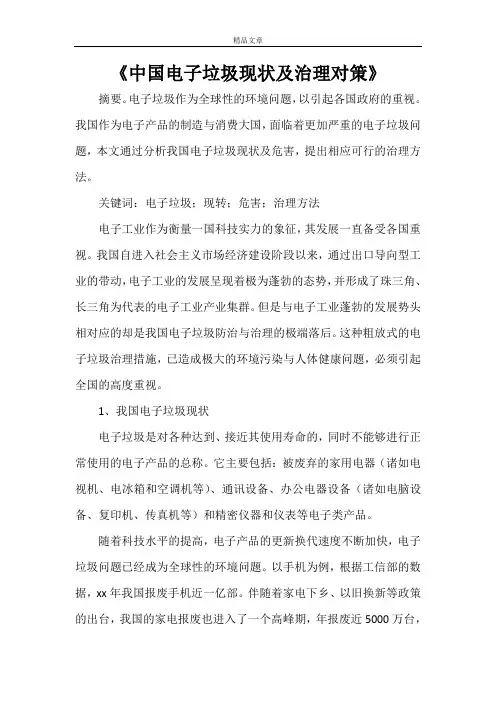
《中国电子垃圾现状及治理对策》摘要。
电子垃圾作为全球性的环境问题,以引起各国政府的重视。
我国作为电子产品的制造与消费大国,面临着更加严重的电子垃圾问题,本文通过分析我国电子垃圾现状及危害,提出相应可行的治理方法。
关键词:电子垃圾;现转;危害;治理方法电子工业作为衡量一国科技实力的象征,其发展一直备受各国重视。
我国自进入社会主义市场经济建设阶段以来,通过出口导向型工业的带动,电子工业的发展呈现着极为蓬勃的态势,并形成了珠三角、长三角为代表的电子工业产业集群。
但是与电子工业蓬勃的发展势头相对应的却是我国电子垃圾防治与治理的极端落后。
这种粗放式的电子垃圾治理措施,已造成极大的环境污染与人体健康问题,必须引起全国的高度重视。
1、我国电子垃圾现状电子垃圾是对各种达到、接近其使用寿命的,同时不能够进行正常使用的电子产品的总称。
它主要包括:被废弃的家用电器(诸如电视机、电冰箱和空调机等)、通讯设备、办公电器设备(诸如电脑设备、复印机、传真机等)和精密仪器和仪表等电子类产品。
随着科技水平的提高,电子产品的更新换代速度不断加快,电子垃圾问题已经成为全球性的环境问题。
以手机为例,根据工信部的数据,xx年我国报废手机近一亿部。
伴随着家电下乡、以旧换新等政策的出台,我国的家电报废也进入了一个高峰期,年报废近5000万台,而且还以20%的增长速率在递增,预计到“十二五”末期,家电年报废量将达到1.6亿多台。
我国目前每年电子垃圾产量达到230万t,仅次于美国的300万t,,呈现着高速增长的趋势。
另一方面,我国不仅要面对国内消费产生的巨大的电子垃圾,还受到国外电子垃圾侵入的威胁。
全球每年从消费过程、生活过程以及维护过程所产生的电子垃圾总量约xx~5000万t,其中约20%~30%的电子垃圾的最终处理和再利用地是在中国。
如此巨大的电子产品报废量,在我国却没有得到很好的处理。
由于相关的法律法规不健全,且缺乏可操作性,造成我国电子废弃物回收体系混乱,加工处理水平低下,在这个体系之中自发形成的回收体系占据着绝大部分;许多电子垃圾的拆解、回收、处理都以家庭小作坊为主。
电子垃圾英语作文初中
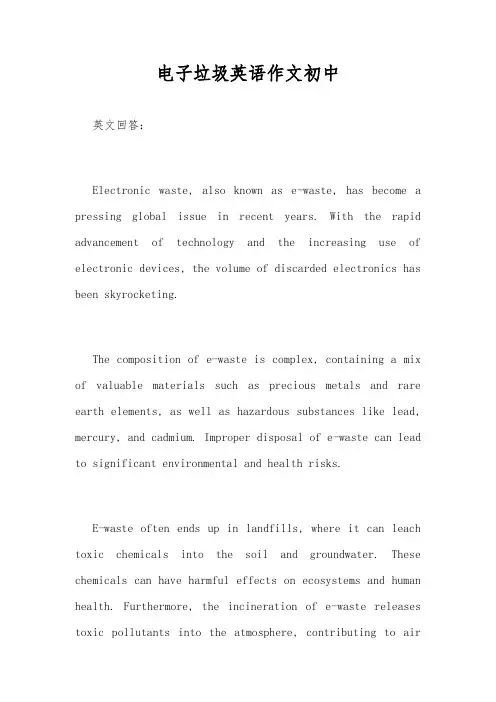
电子垃圾英语作文初中英文回答:Electronic waste, also known as e-waste, has become a pressing global issue in recent years. With the rapid advancement of technology and the increasing use of electronic devices, the volume of discarded electronics has been skyrocketing.The composition of e-waste is complex, containing a mix of valuable materials such as precious metals and rare earth elements, as well as hazardous substances like lead, mercury, and cadmium. Improper disposal of e-waste can lead to significant environmental and health risks.E-waste often ends up in landfills, where it can leach toxic chemicals into the soil and groundwater. These chemicals can have harmful effects on ecosystems and human health. Furthermore, the incineration of e-waste releases toxic pollutants into the atmosphere, contributing to airpollution and respiratory problems.The problem of e-waste is further compounded by the fact that it is often shipped to developing countries for recycling. These countries often lack the infrastructure and expertise to handle e-waste safely, leading to environmental degradation and health hazards for local communities.Addressing the e-waste problem requires a multi-pronged approach. Governments, businesses, and individuals all have a role to play. Governments can implement regulations to encourage responsible e-waste recycling and disposal. Businesses can design products with durability and recyclability in mind. Individuals can reduce their e-waste footprint by extending the lifespan of their electronics, repairing them when possible, and recycling them responsibly.By taking collective action, we can mitigate the harmful effects of e-waste and protect the environment for futuregenerations.中文回答:电子垃圾,也被称为电废物,近年来已成为一个紧迫的全球性问题。
英语作文电子垃圾的危害
英语作文电子垃圾的危害English:Electronic waste, or e-waste, poses significant hazards to the environment and human health. The improper disposal of electronic products containing toxic substances such as lead, mercury, and cadmium can result in groundwater contamination and air pollution. When these harmful chemicals seep into the soil and water sources, they can pose serious health risks to both humans and wildlife. In addition, the rapid rate at which electronic devices are being discarded has led to overflowing landfills and the release of harmful emissions from incineration. Furthermore, the process of extracting raw materials from electronic waste contributes to environmental degradation and the depletion of natural resources. It is crucial for individuals and businesses to properly recycle and dispose of electronic waste to mitigate these harmful effects and promote sustainability.中文翻译:电子垃圾对环境和人类健康造成了重大危害。
处理电子垃圾英语作文
处理电子垃圾英语作文Electronic waste, commonly known as e-waste, has become a growing concern worldwide, posing significant environmental and health hazards. As the rapid advancement of technology continues to fuel the demand for electronic devices, the disposal of outdated and unwanted electronics has become a pressing issue. The proper management and disposal of e-waste are crucial to mitigating its negative impacts on the environment and human health.The challenge with e-waste lies in its complex composition and potential for harmful substances. Electronics contain a range of materials, including metals, plastics, and chemicals, many of which can be harmful to the environment if not disposed of properly. For instance, lead, cadmium, and mercury are common components in some electronic devices that can contaminate soil and water bodies, affecting both ecosystems and human health.Furthermore, the informal recycling of e-waste often leads to even more environmental degradation. In many developing countries, e-waste is handled by unregulated and untrained individuals who use primitive methods to extractvaluable materials. This informal recycling process often results in the release of harmful substances into the environment, causing soil and water pollution.To address these challenges, it is imperative to adopt sustainable solutions for e-waste management. Firstly, promoting awareness and education about the proper disposal of electronics is crucial. People need to be informed about the hazards of improper disposal and encouraged to recycle their electronics instead of discarding them. Governments and organizations can play a pivotal role in this by conducting awareness campaigns and providing recycling facilities.Secondly, implementing strict regulations and policies on e-waste management is necessary. Governments should enforce laws that prohibit the dumping of e-waste and promote the use of recycling and refurbishing methods. Additionally, they should encourage the production of electronic devices that are easy to disassemble and recycle, thus facilitating a circular economy.Thirdly, investing in technology and infrastructure for e-waste recycling is essential. Advanced recyclingtechniques and technologies can recover valuable materials from e-waste efficiently and safely. Governments andprivate sector companies should collaborate to invest in such technologies and establish recycling centers that can handle e-waste in an environmentally responsible manner.Lastly, promoting the reuse and refurbishment of electronics is another effective way to reduce e-waste. By refurbishing and reusing old electronics, we can reduce the demand for new devices, thus limiting the generation of e-waste. Organizations and individuals can contribute to this by donating their unwanted electronics or purchasing refurbished devices instead of new ones.In conclusion, the proper management and disposal of e-waste are crucial for protecting our environment and human health. By promoting awareness, implementing regulations, investing in technology, and encouraging reuse and refurbishment, we can ensure that e-waste is handled responsibly and contribute to a sustainable future.**电子垃圾的处理:挑战与解决方案**电子垃圾,通常被称为电子废弃物,已成为全球日益关注的问题,对环境和人类健康构成重大威胁。
电子垃圾课题研究报告范文
电子垃圾课题研究报告范文引言:随着科技的迅猛发展,电子产品的广泛普及和更新换代使得电子垃圾问题日益突出。
电子垃圾给环境带来了严重的污染和资源浪费问题。
为了更好地了解电子垃圾的现状和对策,本报告对电子垃圾的来源、影响以及处理方法进行了研究和分析。
一、电子垃圾的来源电子垃圾主要来源于日常生活以及各个产业领域。
个人消费中废弃的电子产品如手机、电脑、电视等是最主要的来源。
此外,随着信息技术的飞速发展,电子垃圾也不断地来自于电子产品的生产制造过程以及废旧的生产设备。
二、电子垃圾的影响电子垃圾对环境和人类健康产生了巨大的影响。
首先,电子垃圾中存在大量的有毒物质,如铅、汞、镉等,这些物质会通过水和土壤的污染影响到生态系统的平衡。
其次,电子垃圾的处理过程中会释放出大量有害气体,导致空气污染。
最后,废弃的电子设备中往往还存在很多有价值的资源,如稀有金属,但由于回收技术不成熟以及缺乏有效的回收体系,这些宝贵的资源被浪费。
三、电子垃圾的处理方法为了应对电子垃圾带来的问题,需要制定合理的处理方法。
首先,应加强对电子产品生命周期的管理,通过推广可持续设计和生产,减少电子垃圾的产生。
其次,加强对电子垃圾的回收与处理,建立高效的回收体系,增加对废旧电子产品的再生利用率。
此外,还可以通过加强宣传教育,提高公众对电子垃圾危害的认识,促使个人减少电子产品的浪费。
结论:电子垃圾问题是当前亟待解决的课题。
通过深入研究和分析,本报告指出了电子垃圾的来源、影响以及处理方法。
只有通过加强管理和回收体系的建设,提高公众的环保意识,才能更好地解决电子垃圾问题,保护环境,促进可持续发展。
希望本报告能为相关研究和实践提供一定的借鉴和参考。
电子废物越境转移---环境问题案例论文
环境问题分析-----电子废物越境转移引入案例:随着社会的不断发展,电子垃圾进入我国的地域已经从广东、浙江地区向上海、福建、湖南和山东等地区蔓延,浙江台州正逐渐成为中国最大的垃圾处理厂。
广东省每年要处理掉来自发达国家的数千万吨电子废物。
汕头市潮阳区贵屿镇,在国际绿色和平组织中国项目负责人赖芸的眼中,它是中国最出名的一个小镇,因为那里被称为全球最大的走私电子垃圾分拆基地。
为了节省成本,这些作坊采用最原始的方式进行生产,并用最简单的遗弃方式处理已经没有回收价值的那些废品:这样做最直接的后果就是环境的高度污染。
拆解电子垃圾撑起小镇的经济发展,也污染了一方水土,遗患无穷,遭致频繁的曝光和外界的压力。
种种的利弊纠缠,成为这个长于拆解电子垃圾的小镇的难解之结。
电子废物,是指废弃的电子电器产品、电子电气设备(以下简称产品或者设备)及废弃零部件、元器件和国家环境保护总局会同有关部门规定纳入电子废物管理的物品、物质。
包括工业生产活动中产生的报废产品或者设备、报废的半成品和下脚料,产品或者设备维修、翻新、再制造过程产生的报废品,日常生活或者为日常生活提供服务的活动中废弃的产品或者设备,以及法律法规禁止生产或者进口的产品或者设备。
那么,是什么引起了电子废物的越境转移呢?首先,发展中国家经济落后、环境标准低及处理成本低,使得电子废物转移成为可能。
发达国家环境保护法律健全、标准高导致其就地处理电子废物的成本高。
而像中国这种发展中国家正处于经济发展阶段,法律法规不够健全,未得到有效的执行。
民众的法律意识较低。
发达国家为了降低成本,保护本国环境,都把废弃物运到发展中国家处理。
此外,电子废物的走私屡禁不止,是因为它们当中蕴含大量的可利用资源;我国资源短缺。
中国人口众多人均占有率低,导致国内金属价格上涨;在发展中国家,劳动力价格低廉,处理成本低。
地方官员腐败,片面追求经济增长,同意电子垃圾进口、法律制度不健全、环境执法效率低等都使这一环境问题变得越来越严峻。
- 1、下载文档前请自行甄别文档内容的完整性,平台不提供额外的编辑、内容补充、找答案等附加服务。
- 2、"仅部分预览"的文档,不可在线预览部分如存在完整性等问题,可反馈申请退款(可完整预览的文档不适用该条件!)。
- 3、如文档侵犯您的权益,请联系客服反馈,我们会尽快为您处理(人工客服工作时间:9:00-18:30)。
我国电子垃圾现状及发展趋势什么是电子垃圾?废弃不用的电子设备都属于电子垃圾。
统计数据显示,全世界2016年电子废物产生量约4610万吨,人均约6.3千克,其中,仅亚洲产生量占全世界的45%。
2010年至2015年间,手机、电脑和其他设备已为亚洲大陆造成了1230万吨电子垃圾,在这段时间内,仅中国人的电子垃圾产生量就增加了一倍以上,达到670万吨。
根据商务部发布的《中国再生资源回收行业发展报告2016》显示,2015年我国五种主要废弃电器电子产品(废电视机、废冰箱、废洗衣机、废空调、废电脑)的回收量约为15274万台,约合348万吨,同比增长12.5%。
我国已成为世界第二大电子垃圾污染国。
这些堆积如山的电子垃圾在对人类与环境带来危害的同时,也蕴藏着巨大的发展潜力。
电子垃圾的第一危害就是重金属污染。
铅在电脑和电视机中主要存在于CRT玻璃屏和印刷电路板中,含量大约占电脑总质量的6.3%~6.5%。
每台电脑中阴极射线管内含有约3.6kg的铅。
铅及其化合物在常温下不易氧化,耐腐蚀。
进入环境中的铅由于不能被生物代谢所分解,因此它在环境中属于持久性污染物。
铅对人体内许多系统均有危害,特别是损伤血液系统、神经系统和肾脏。
镉在半导体和SMD芯片电阻的制造中使用,通过吸入或食入进入人体。
镉对人体的危害属于不可逆转的一类,因为它的半衰期很长,约30年,可在体内蓄积,损伤肺部、肾脏和骨骼。
激光打印机和复印机中的碳粉也是导致从事打印和复印工作人员肺癌发病率升高的元凶。
其次,家电壳体塑料对环境的污染也不应忽视。
据估算,电脑和电视机中塑料的平均质量比例为23%~25%。
这些塑料中聚氯乙烯(PVC)约占26%。
PVC是严重污染环境和有害人体健康的塑料品种之一,由于PVC很难回收利用,一旦燃烧会产生二恶英和呋喃,具有极强的毒性和致癌性,目前在很多领域开始不用PVC作为原料,使用其他聚合材料代替PVC,如PE,PP,PU,ABS等,大多数聚合物的阻燃性远低于PVC,为此,通常向塑料配方中加入阻燃剂,一般是含溴元素的有机化合物,如聚溴化二苯醚(PBDE)和聚溴联苯(PBB),这类阻燃剂会引起人体内分泌的干扰,诱发神经系统的损害,还有可能增加消化及淋巴系统致癌的危险。
最近的研究发现,人类乳汁中聚溴化二苯醚的含量(质量分数)每5年增加1倍。
最后是在处理电子垃圾过程中产生的危害。
目前中国尚未建立电子垃圾回收的正常渠道,小商小贩已成为中国回收电子垃圾的主力军。
有些地方对于普通电池已采取措施进行回收,但仍有很大一部分电池被随意丢弃,废旧手机电池的回收寥寥无几,这些都是污染环境的隐患。
对于废旧家用电器的回收,一是被简单处理后又流入低收入家庭或农村;二是被拆解后其中仍有一定使用价值的元件被翻新改装,再次流入市场,而没有利用价值的部件扔掉后被填埋或焚烧,大量有毒物质因此污染土壤和地下水。
在中国,一些人仅靠一把锤子和一个酸池即能在电子垃圾中不断“淘金”。
然而,这些“淘金”者在发财致富的同时,也引发出许多环境问题。
许多人为了从废旧电脑芯片中提取金,经常使用“王水”,在这个过程中会导致大量酸性气体挥发,甚至在很远的地方都能看到烟雾,而大部分经王水处理过的废料被直接倒入河里、渗入地下。
对于电脑主机、显示器和键盘等物品的塑料部分,则被送到熔化炉熔化,此操作过程充满了溴化阻燃物,有可能产生二恶英。
为了应对日益增长的电子垃圾,我国先后颁布实施了《固体废物污染环境防治法》、《清洁生产促进法》等法律法规,对电子垃圾的回收处理做出了相应规定。
根据这两部法律的相关规定,国务院于2009年2月出台了《废弃电器电子产品回收处理管理条例》,《条例》针对电器电子产品的回收处理活动作出规范,我国电子垃圾的回收和处置也步入了新时代。
根据《条例》,2015年发展改革委等6部门联合发布了新版《废弃电器电子产品处理目录》,电子废弃物由上述五种废弃电器电子产品扩展至打印机、手机等14个品类。
在电器电子产品污染控制方面,2016年1月,工业和信息化部会同发展改革委等8部门发布了《电器电子产品有害物质限制使用管理办法》。
在原《电子信息产品污染控制管理办法》基础上,新《办法》扩大了限制使用的有害物质范围并完善了产品有害物质限制使用的管理方式。
但是我国电子垃圾回收仍处于粗放无序的状态,大部分废弃电器电子设备都是由个体散户回收,并由小作坊进行简单的拆解和加工。
在这种非专业的拆解和加工过程中,不仅部分宝贵资源未得到充分回收,而且产生了大量二次垃圾和污染物。
这些二次垃圾和污染物常与生活垃圾混合后填埋或焚烧,进而对水、土壤和空气产生严重危害。
根据商务部统计数据,截至2015年底,我国废弃电器电子产品处理企业数量达到109家。
然而,很多正规的电子废弃物处理企业因无法回收到可维持企业正常产能的电子垃圾,得不到良性发展。
究其原因,一方面是我国在电子垃圾回收处理方面的法律不完善,未建立有效健全的回收管理体系及制度,例如责任主体不明确、管理制度可操作性不强;另一方面,公众的电子垃圾回收意识薄弱、社会正确引导不力,导致电子垃圾无法集中回收。
此外,尽管在我国《禁止进口固体废物目录》中,明确将废弃电器电子产品列入禁止进口的目录当中,但每年仍有大量电子垃圾通过非法渠道进入我国。
而这些电子垃圾无法得到专业的回收再利用以及无害化处理处置,严重危及地区生态环境和公众身体健康。
因此,尽快完善电子垃圾回收体系、增强公众环保意识、打击非法回收渠道势在必行。
目前,中国很多地方都存在着电子垃圾的拆解场和集散地,而且其中大多数都在用“19世纪的技术来处理21世纪的废物”。
由于处理手段极为原始,只能通过焚烧、破碎、倾倒、浓酸提取贵重金属、废液直接排放等方法处理,造成了极其严重的生态恶果。
从河岸沉积物的抽样化验显示,对生物体有严重危害的重金属钡的质量浓度10倍于土壤污染危险临界值,锡为152倍、铬为1338倍、铅为危险污染标准的212倍,而水中的污染物超过饮用水标准数千倍。
为了减轻电子垃圾的危害,我国还需要加强法制建设 ,明确责任。
要通过立法明确限制有害物质在电子产品中的应用 ,如严格规定电子产品中有毒重金属的含量水平 ,热塑性塑料中有毒助剂的含量水平 ,并有监管部门对各相关产品进行认证。
在废弃物的处置过程中国际社会达成共识,即“生产延伸责任”,指生产者不仅要对生产过程中产生的环境污染负责,还要对产品在整个生命周期内对环境的影响负责。
作为电子企业,不能只局限于生产制造过程的清洁化必须涵盖其产品的整个生命周期,必须对电子垃圾问题的有效解决扮演主要角色。
随着有关法律、法规的完善 ,提升公众电子废弃物循环利用的意识 ,最终促进整个产业的良性发展。
.除此之外,面对电子垃圾的威胁 ,必须尽快建立全社会的回收系统。
在几年来对电子垃圾基本信息收集、调研和回收试点经验总结的基础上 ,国家发改委、信息产业部和国家环保总局等部门联合发布了《建立中国废弃家电及电子产品回收处理体系初步方案》,首次提出以“生产者责任制”为核心的废旧家电回收处理体系,明确规定家电生产企业、经销商、消费者、处理公司和政府部门都必须承担相应的责任和义务。
生产企业必须在源头上控制住有毒、有害物质的使用 ,采用有利于产品回收和再利用的设计方案;经销商可以接受生产企业委托 ,回收废旧家电 ,交给有处理资质的公司进行处理;销售的二手电器要符合质量标准;消费者有义务把废旧家电交给生产企业或有处理资质的公司;家电处理公司必须得到相关部门的认证 ,经其检测、维修后达到二手家电质量标准的电器贴上“再利用品”标志后出售 ,氟里昂等有害物质必须交环保部门处理;政府部门负责制订相关法律法规 ,规范、引导、监管回收处理过程。
尽快建立市场准入机制 ,保证有能力、有资质的企业进入废旧电子产品拆解市场 ,扶助专业电子垃圾处理企业进行技术升级 ,实现规模化无污染生产 ,坚决取缔用落后工艺提取贵金属的小作坊和污染严重的企业 ,彻底清理整顿进口废旧电器的非法市场。
另外 ,对积极参与电子垃圾回收利用的科研单位和企业 ,要给予政策和资金倾斜 ,确保其产品的优先推广。
最后,我们要发展循环经济 ,走产业化之路。
德国实际生活中的许多做法很符合“循环经济”的理念我们可以加以借鉴。
就以废旧家用电器来说 ,在波恩这个小城 ,每年有 2 天是收废旧家电的日子 ,市民会把自己家里淘汰的旧电视、冰箱、收音机等拿出来 ,统一堆在路边 ,由市政公司收走处理。
在市政公司有专门的工厂处理旧电器。
拿废旧冰箱来说 ,先由一些工人手工操作 ,将其中残存的制冷剂放出 ,以免后续处理中泄漏出来污染环境;然后是自动化的程序 ,用机器先将其压扁、锤碎 ,再将不同的成分筛选出来。
例如:先根据导电性将金属和非金属分开 ,再根据磁性和密度筛选出钢铁、铜、铝等不同金属。
几条分选流水线过去 ,出来的就是成分比较单一的各种碎片 ,回收的金属回炉冶炼后又是好材料。
合成塑料可以再生成更低级的塑料或者干脆作为燃料 ,而合成橡胶粉碎后可以和沥青搀在一起 ,成为铺路材料。
电子垃圾中包含着纯度很高的金属物质 ,可产生巨大的经济效益,其循环利用的前景十分可观 ,应加大电子垃圾处理技术的研究力度。
企业化运作需要一些政策和法规等方面的配套措施。
国家要规范电子垃圾的回收渠道 ,通过定点回收、分选分送、终端处理等可控性流程 ,建立市场经济条件下的垃圾循环利用的合理途径,实现电子垃圾循环利用市场化、产业化发展。
同时电子垃圾的处理需要较高的技术能力和配套设施 ,前期投入巨大 ,需要国家的大力扶持 ,并通过融资体制改革 ,实现电子再循环企业的市场化运营。
电子垃圾处理是通过对电子废弃物进行回收处理和再生利用,实现有效利用资源和减少环境负荷的一个新兴产业。
在产业空间方面,我国电子垃圾处理行业市场巨大,国家通过规划和建设新兴产业的工业园区,实现新兴产业在地理、资金、人力资本等方面的集中,形成产业群;我国电子废弃物的种类多、数量大、价值高,常规处理电子废弃物的技术相对成熟,在经济价值、先进技术和产业政策等方面,国家积极推行鼓励资源循环再生的政策,这些充分说明了产业具有强大的发展动力。
在国家的支持下,既有良好的产业空间,又有强大的发展动力,我国电子废弃物产业势必会有比较好的发展前景,也会创造出较多的就业机会。
此外,我国处理电子废弃物的企业分布范围较广,主要集中在冶金、化工和物资回收行业。
据统计,全国目前有电子废弃物处理的注册企业200多家,未注册的家庭作坊1500多家。
而且其中许多从事电子废弃物处理的企业只是把电子废弃物的再生利用当作企业的一部分业务。
随着国家产业政策的完善和公民环境意识的提高,电子废弃物的处理产业将进入非常好的发展时期。
2016-2021年中国电子垃圾处理行业市场需求与投资咨询报告分析,2016年是“十三五”规划的开元之年,在国家政策推动下,电子垃圾处理体系设将会大幅提升。
